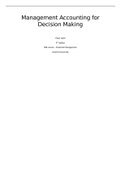Management Accounting for
Decision Making
Peter Atrill
9th edition
FBE course – Financial Management
Utrecht University
,Chapter 1 – introduction to management accounting
Strategic management
Strategic management: Provides a business with a clear sense of purpose
along with a series of steps to achieve that purpose: establishing the long-
term direction for the business. It involves setting long-term goals and
then ensuring that they are implemented effectively.
1 Establish mission, vision and objectives
The first step is to establish the mission of a business, which may be set
out in the form of a mission statement. This is a concise declaration of the
overriding purpose of the business. It addresses the question ‘What
business are we in?’
The vision statement declares the business’s aspirations and addresses
the question ‘What do we want to achieve?’
Objectives must be developed in order to translate the mission and vision
into specific commitments. They should provide clear targets, or outcomes, which are both
challenging and achievable. They should also provide the basis for assessing actual performance.
In practice, the objectives set by a business are likely to range across all key areas and might include a
commitment to achieve: (businesses do not normally make their statement of objectives public)
- A specified percentage share of the market in which the business competes;
- A high level of customer satisfaction;
- A high degree of employee involvement;
- A specified percentage of sales revenue being generated from newly-developed products;
- High standards of ethical behaviour in business dealings;
- A specified percentage operating profit margin (operating profit as a percentage of sales
revenue);
- A specified percentage return on capital employed.
2 Undertake a position analysis
The position analysis seeks to discover how, given its attributes, the business is placed in relation to
its environment (customers, competitors, suppliers, technology, the economy, political climate, etc.).
This will be carried out in the context of its mission, vision and objectives.
SWOT analysis: the framework of the business’s strengths, weaknesses (internal), opportunities and
threats (external).
3 Identify and assess the strategic options
This involves trying to identify possible courses of action. Each of the options identified should assist
the business in reaching its objectives by using its strengths to exploit opportunities, while not
exposing its weaknesses to threats.
4 Select strategic options and formulate plans
The business will select what appears to be the best of the courses of action or strategies available,
taking the mission, vision and objectives into account.
, 5 Perform, review and control
The business must implement the plans derived in step 4. The actual outcome will be monitored and
compared with the plans to see whether things are progressing satisfactorily. Steps must be taken to
exercise control where actual performance fails to match earlier planned performance.
Financial objective of a business
Main objective: enhancing the wealth of its owners. If the managers do not provide the expected
increase in ownership wealth, the owners have the power to replace the existing management team
with a new team that is more responsive to owners’ needs. However, for longer-term survival
businesses should also take the wishes of other stakeholders into account, such as employees,
customers, suppliers, the community, etc.
Balancing risk and return
The relationship between risk and return has important implications for setting financial objectives
for a business. The owners will require a minimum return to induce them to invest at all, but will
require an additional return to compensate for taking risks; the higher the risk, the higher the
required return.
Management accounting
Management accounting (MA) provides economic information to their ‘clients’, the managers. It
must be relevant and it must faithfully represent what it is supposed to represent.
Relevance: MA information should make a difference by being capable of influencing managers’
decisions. It must help to predict future events or help to confirm past events to check on the
accuracy of their earlier predictions. Helps to improve future predictions. To be relevant, MA
information must cross a threshold of materiality – when its mission statement could alter the
decisions that managers make.
Faithfull representation: To provide a perfectly faithful representation, the information provided
should be:
- Complete: it should incorporate everything needed for managers to understand what is
being portrayed;
- Neutral: the information should be presented and selected without bias;
- Free from error: this is not the same as saying that information must be perfectly accurate. It
should aim to do so, insofar as possible.
Other qualities could enhance the usefulness of MA information in addition: comparability,
verifiability, timeliness and understandability.
Comparability Managers might want to compare performance of the business over time, or certain
aspects of business performance to those of similar businesses. Better comparisons can be made
where the MA system treats items that that are basically the same in the same way and where
policies for measuring and presenting MA information are made clear.
Verifiability This quality provides assurance to users that the MA information provided faithfully
represents what it’s supposed to represent. MA information is verifiable where different,
independent experts could reach a consensus that it provides a faithful portrayal. Verifiable
information tends to be supported by evidence, such as an invoice stating the cost of some item or
inventories.




